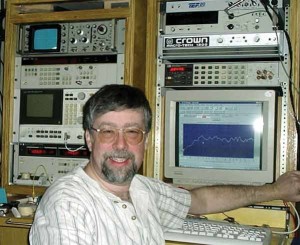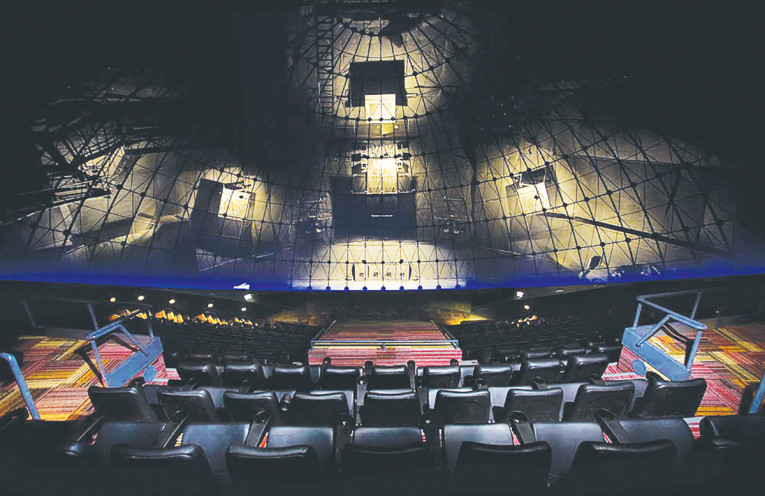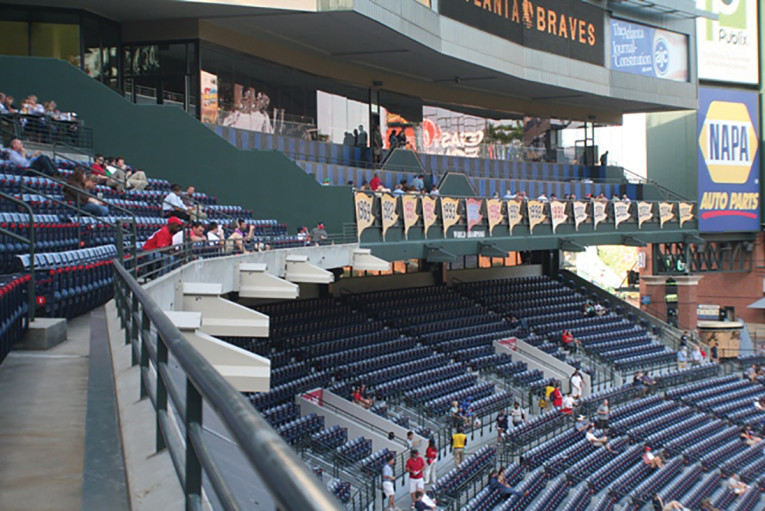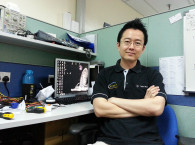
Director of Research and
Development for Danley Sound Labs.
The Innovator Behind Synergy Horns
Curiosity and ingenuity prove to be a powerful combination
SHANNON BECKER: Tell us a little about your background and where you live.
TOM DANLEY: I grew up in northern Illinois in an area that wasn’t heavily developed, in the same neighborhood where my mom grew up. My brothers and I spent a lot of time outside, playing in the woods and exploring the marsh. We were poor compared to most people in our town, but I wasn’t aware of that until school, when I seemed to be reminded of that regularly. To this day, I have a fondness for wildlife and nature, and I prefer the woods as scenery.
My dad was a DIYer and very mechanical. My parents built a structure that had been used as a chicken coop into the house where I grew up. Dad was very handy, skilled at building things. He had a workshop where I spent time watching him, and eventually I was able to use Dad’s tools.
By about age 12, I knew how to arc weld with Dad’s homemade V-8 powered welder and I had used his metal lathe. At one point somewhere around that same time, I made the transition from taking apart everything I could find to fixing my first radio.
It’s funny. Back then, the garbage man, several neighbors, and some of our relatives brought me broken radios and electronic stuff to take apart. My mom didn’t like my bedroom full of electronic parts and the occasional broken vacuum tubes, and so forth, but she allowed it. Dad was a mechanical guy, but he didn’t like electricity. I think that may have been my secret ally. Mom had an amazing knowledge of the local nature, history, plants, and animals. And a few times, I thought she might have ESP, which as a teen was kind of creepy. In high school, I got my first job in electronics. It was a part-time job at a local TV store called 20th Century TV. I tested tubes on incoming TVs at first, then later I repaired black-and-white TVs and I put new eight-track players and speakers in cars for customers and a couple of car dealers.
While it was my first real job in electronics, I still think of Mr. Reynolds, my boss, as one of the most fair, even-tempered bosses I ever had. At this time, I was in a band playing bass, building loudspeakers and 200-W tube power amplifiers with repair output transformers from Sunn and other parts from Fair Radio.
Several publications of note turned out to be very important in my life. A quick perusal of my bookshelf shows Audio Amateur magazines going back to April 1976, a thick row of Glass Audio and Speaker Builder magazines.
One reason I agreed to be interviewed is that these publications changed my life in a significant way. No doubt there are countless others whose paths were affected by Ed Dell, and I believe strongly that one thing our country needs are more people who do things, experiment, and invent. Trust me, even a guy (myself) who took five years to graduate from high school can teach himself a great deal. An education doesn’t teach curiosity, problem solving, or creativity.
While I have built loudspeakers most of my life and I have occasionally mixed sound, I have also had to have something significant others have helpfully called a “real job” and that was usually in electronics repair. I had built and repaired a lot of electronics by the mid 1970s, and I expected the job at Grommes Precision, an amplifier company, to be an easy “real job.” Funny how wrong one can be. The point being, when you repair something that is broken, you know it is wired correctly but you have one or more bad parts. When you troubleshoot hand-wired tube amplifiers (every one that is produced has to be tested), you find the parts are usually good. If it doesn’t work, anything could be wired wrong—emphasis on anything. Anyway, it was a good experience, a completely different kind of troubleshooting than what I was used to, and I eventually got to work part of the time in engineering, but it was too far away.
In 1979, I worked for a company called DSI that made computer tape readers and punches. These long paper tapes that had the instructions on them were used to program CNC machines back then. At DSI, I learned digital electronic logic repair. Compared to analog, that is simple in operation but large on complexity. Anyway, when I was asked to take a crack at the Kleinschmidt Teleprinters and managed to fix one, that became part of my job. These were very complicated machines and while this made them slightly fun to work on, I grew to dread them too.

A co-worker had applied at a small NASA contractor that oddly was right down the street. He didn’t get the job so he told me about it. I applied and got the job at Intersonics, a small company that was trying to do acoustic levitation. That is a non-magical way of suspending an object in midair using intense sound. The idea was, in zero gravity, one could position a sample within a furnace and melt/process it at very high temperatures without any adverse effects from the container. For me, those 17 years were spent in a wonderful environment. One of my bosses was an English acoustician from Mullard Labs who developed the BQS6 sonar transducers. Another boss was a physicist who taught and then worked at Fermi labs.
It was a great opportunity because they really did have sort of a blank sheet of paper and a big list of questions. I was able to find solutions to a number of the problems and I invented a new sound source at 100 times greater efficiency. I became more confident in my work and when I got my first and second patents, I really started to feel like I had overcome my experiences at Deerfield High School.
Eventually, the company grew, I had more inventions, and we flew payloads on several sounding rockets, zero-gravity aircraft flights, and the space shuttle flights STS-7 and STS-51A. My title eventually became Director of Electroacoustic Research. But, the shuttle disaster was the beginning of the end for the company. The work on the space station manufacturing bay stopped and all of that work gradually dried up. I had designed and built large portions of several flight payloads and had the chance to begin astronaut training as a payload support specialist about a year before the accident. I elected not to continue because of my interest in loudspeakers. I wasn’t sure about that decision then, but later I was glad I had made it.
SHANNON: How did you become interested in audio electronics?
TOM: I would say several steps led up to it. Around age 5, I heard my grandfather’s Heathkit mono hi-fi playing a recording that had French horns. Grandpa lived next door and played a French horn (which didn’t make as big of an impression on me), but I was baffled about how the wooden boxes and his stuff with the little light bulbs (tubes) made the sounds. Also, what eventually became just as interesting, I wanted to understand how the music got into the black discs on the thing I was told not to touch (the turntable).
I did chores for Grandpa and in exchange he bought a Heathkit crystal radio kit for me. I’ll never forget lying in bed with an antenna wire strung around the room and over my bunk bed, listening to WGN while I was buried under my covers. For most of my life, I had a shortwave radio next to my bed as well, which over the decades resulted in a healthy skepticism of our domestic news media. But it was entirely entertaining and awe inspiring for my two young daughters, who shared my fascination with how the radio worked. (I guess they took after their father.)
At about age 7 or 8, my uncle demonstrated an old telephone’s hand-crank generator by giving me a decent shock. That was baffling, how something that felt so strong could be invisible. The shock was a mystery but happened every time. He later gave me the generator. I eventually brought it to school and had my third-grade class hold hands (including me and the teacher) in a circle. It gave us all a mild shock. Electricity was cool! If you hid the wires carefully, you could even electrify swing set chains turning the swing into something like an ejection seat. (I know from experience, as did the neighborhood kids.)
Another turning point in my life occurred around 1974. After high school, I made live sound speakers for TC Furlong and did the sound mixing for bands. I had a bunch of friends who were going to meet at the club where I was mixing, so I thought it would be fun to record the night on my reel-to-reel tape deck.
I plugged into the full-range output from the board, Y’d it into my tape deck, and flipped the tape at break. When I got home at 3:00 A.M. that night, I was too awake to go right to bed, so I set up the tape and listened to it. I was dumbstruck. At home, it was near record quality. It sounded so different than the live club that I listened to it twice, both sides. What I had on tape was the full-range signal that went to the active crossover, amps, and loudspeakers. It was apparent that the huge difference in sound recorded vs. live was a result of the loudspeakers.
I wouldn’t have guessed it at the time, but each of these events sparked an interest in sound, electricity, and loudspeakers or seemed to have set my compass heading.
SHANNON: What was your first audio technology project? Can you describe it? Is it still in use today?
TOM: The first audio thing I was ever paid for was a pair of speakers I made for my grandfather. When I was about 17 or 18, he commissioned me to build a pair of speakers for his basement. I made many pairs of loudspeakers and a couple sound systems in the 1970s, but I doubt any of them still exist. My first successful commercial loudspeaker product was in the 1980s.
During an airplane trip, I was paging through a surplus catalog when I thought of trying to use a surplus low-inertia DC servomotor to replace the voice coil in a woofer. One motor caught my eye, and I had seen two of them at the local surplus store, Harrison Supply. When I got home, I went and bought them for $12 each.
My third prototype sounded good enough to bring to work and demonstrate. My bosses were both impressed, and Roy, who was a hi-fi buff and World War II acoustician from Mullard Labs, later told me I could start a small loudspeaker division in the shop as long as its only cost was space and lights. I had some “cred” by then with Roy, who knew I had hand built electrostatic speakers, and he asked me to disable the protection spark gaps in his ESL-63s. (They sparked at just the wrong times.) Very hesitantly I agreed and took them home to take apart and “fix.”
The servodrive woofers we made there were used for special effects at Disney World, the Mirage casino’s volcano, and the “low end” for tours for Michael Jackson, U2, Garth Brooks, Def Leppard, and so on. While these were much more powerful than conventional subwoofers, the motors were remnants of the computer tape memory era, and when they were no longer needed, the price for the motors skyrocketed them into extinction.
SHANNON: Tell us about your company, Danley Sound Labs, and the role you play within the company. To what do your attribute your company’s continuing success?
TOM: I credit my associate Mike Hedden (Danley Sound Labs president/CEO) with much of the company’s growth. And he followed a very logical but nontraditional path to expand the company. I am blessed to have him as my co-worker and friend. As for my part, I invented and developed the technologies we use, including the Synergy horn, the Tapped horn, the Paraline, the Shaded Amplitude horn, and the Layered combiner. I also designed most of the products that use them.
Actually those things are a small part of what a company does. A good idea on its own is something like a one-legged table (not that useful on its own). While my job is the most fun (I think), when I send my drawings to Tom Wilson, our CAD guy, he figures out the easiest/best ways to make the product. After a final look, his 3-D CAD drawings are sent to the cabinet shop where the CNC machines get programmed based on those drawings and so on. Early on, I may make a prototype or mock-up a part of it to test, but the very large cabinets are too complicated to build at home.
Our success? Again, it is a number of things acting together, a synergy. The team Mike has assembled including Ivan Beaver, Chad Edwardson, Tom Wilson, and Doug Jones, and so on are people who are passionate about sound. Some years ago for a trade show, we had T-shirts made that said: “Sit down and listen. It’s about the sound, it’s why you got into audio.”
For my part, the team members have more of an idea what they need to do than I do. When they tell me what they need, it is more an outline of what a product needs to do. The “how and what” part is entirely up to me. I like to say that the better I see the target, the more likely I will be able design something to hit it. The best part is no one says you have to do it this way or that way. I can design and test whatever I imagine, as long as it gets the job done.
Sonically, Synergy horn’s success is simple but one has to hear it. It is a way to combine more than one driver in more than one frequency range into a single, constant directivity horn with the appropriate crossover. The outcome literally appears to be, measures like, and sounds like a single crossover-less driver.
That sounds simple, but it is surprisingly hard to do. An example of its effect is that you can walk up to the speaker, move around, literally even put your head deep into the horn mouth of a three-way Synergy horn, and never hear any clue there is more than one driver. Many of them can even reproduce a square wave over a broad band, even with a passive crossover. In large-scale sound, this sounds dramatically different than the concert-style arrays.
SHANNON: You hold 17 patents on a variety of acoustic and electromagnetic devices. Where do your ideas originate?
TOM: Well, there are a couple new ones to add. To be current, the Tapped horn, Synergy horn, Paraline, and Shaded Amplitude horn have been issued, and the Layered combiner will be soon.
As to where they come from, I can try to describe the process. It begins with a problem to solve. The best solutions come when you find the simplest answer whose form is driven by the problem and conditions. With the Synergy horn, for example, the solution should have constant directivity, and it should act like one source in time and space so it will not have lobes and nulls in its dispersion pattern.
Sometimes solutions to these issues happen in a flash, sometimes it takes months to work out a solution. The Layered combiner used in the J-series horns was the hardest loudspeaker design I have worked on so far. It took four months to get from a fleeting mental image of “I think I see how” to a drawing that could be built.
SHANNON: Can you describe one or two of your inventions?
TOM: Thirty years later, I still get a kick out of acoustic levitation. Using high intensity sound you can position/levitate an object in midair. In the 1990s at Intersonics, I demonstrated acoustic levitation for a movie called “Mystery of the Sphinx.” If you visit www.youtube.com/watch?v=NhDmCuffwOI, the scene is about 50 min into movie.
If you Google “Argonne acoustic levitation,” you can find a link to a recent video demonstration using the levitation sound sources I developed.

My inventions include the Synergy and Tapped Horn systems, and Shaded Amplitude Synergy horns. The Synergy and Tapped horn system is used at some of the large Omnimax to Imax conversion theaters.
The Shaded Amplitude horns are the “things” that look like birdhouses that overhang the edge of the balconies at Turner Field in Atlanta, GA. With the Shaded Amplitude horns, energy projected to the front row is much louder than that projected directly below, so the measured sound pressure level (SPL) only varies about ±1 dB over the seating area.
SHANNON: Which of your inventions would you describe as a “game changer” in your field?
TOM: My “game changer” would have to be the large J-series Synergy horns. In the stadium sound area (e.g., football- and baseball-sized venues) it is most difficult to get good sound.

It is also an area where the decision makers don’t care about brand identity or who tours with X, Y, or Z speakers. There are no live-sound style riders and basically the only thing they care about is getting better sound. So for a company like ours that doesn’t do a lot of marketing, this is a level playing field. The concert systems that evolved for that market may be the best they know how to make, but they radiate an interference pattern you can hear if the wind blows. Every location has a different sound and radiate sound in the wrong directions. When you can eliminate all that interference, radiates enough acoustic power with one single source, and have more directivity, then it becomes a pretty obvious sonic choice. It’s as close to hi-fi as you can get on a grand scale.
The familiar large sound systems are a huge array of sources, which depend on DSP, and sound worse the larger they are. The Synergy horns work because the source is acoustically correct at the origin.
SHANNON: Do you have any inventions that might soon be released?
TOM: Oh, now that wouldn’t be fair. But, at InfoComm 2013 (in June), we introduced a new stadium-sized Synergy loudspeaker with a working distance of 1,000’ that utilizes more than 100 drivers acting as one source.
SHANNON: Where does your affinity for low frequencies originate? What makes them so appealing to you?
TOM: At about age 9, I remember helping my grandfather clean up after a service at our church. I used to explore the building and on a previous visit I found a ladder in a back closet that led to the organ pipe loft where I found a confusing maze of tubes and pipes. Very complicated plus wires plus sound equals very interesting to me. I was especially interested in the device after hearing about a time when the organ’s blower motor failed. The organist banged on the floor and my grandfather and two other church members managed to turn the shaft with their feet enough for her to play weakly. As a child, I loved fans so this was already cool.
That day, I spied the organist coming back to practice and, being curious, I snuck into the pipe loft. In that room, the pipes—rather the sound—shook my body. I didn’t know if I should run or stay perfectly still. Nothing was moving or otherwise scary, there was just the intense sound, so I stayed and listened for a while. It was by far the loudest musical experience of my life for a good number of years.
SHANNON: Where do you see the audio industry in 10 years?
TOM: In a way, the direction some of the industry has gone is disappointing. I would have given a great deal to be able to record like you can now with even a MI grade recorder, yet there are fewer bands. And, there are even fewer bands that can play well live or even have people who are interested in playing instruments. Like many industries, the home audio market is so focused on profits that fantastic technology goes unused, and many companies have lost focus on the need for high-quality audio products. Great progress exists for measuring and DSP products but often the companies are more focused on profits than the advancement of the art.
In the late 1990s, I brought a state-of-the-art TDS measuring system that was the size of a suitcase and the weight of a car battery to Egypt to measure the Great Pyramids’ acoustics for a movie (www.livesoundint.com/archives/2000/julyaug/pyramid/pyramid.php). It was a serious armload to carry. Now, you can perform many more measurements and do them faster using an iPad and an interface.
As for me, I would say we still have a ways to go before you can be reliably fooled by a reproduced sonic “environment” or even being able to capture a remote environment. If you include a loudspeaker in a simple “old-time” generation loss recording test, even an anechoic one (where there is no room contribution), you find even good loudspeakers—unlike any other part of the chain—only go a few generations before sounding bad. I hope the industry eventually puts more emphasis on sound quality, the recording industry ends the volume wars, and the listeners win. Keep building. aX





